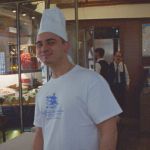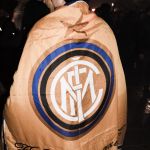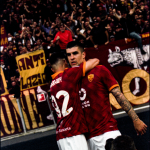
A culinary guide to Rome's Stadio Olimpico
Because eating at the stadium is more complicated than you think
February 12th, 2019
Giulio Pecci
Let's not ignore it, football and food are the foundations of the average Italian - especially male, although fortunately this is no longer the rule. They are what is most present in his daily life, to which he dedicates himself with a passion and an incomprehensible dedication to most people. It is therefore difficult to understand how even today, in 2019, at the Stadio Olimpico in Rome we are not able to effectively combine these two of our great talents. The "culture of the mom's sandwich" remains the only culinary security for young Romans who venture on their journey to the stadium. Here we do not lack delicious traditional dishes, but belong mostly to the culture of the tavern dating back to the early twentieth century, which includes a wooden table and a bench, a paper tablecloth and a good red wine in the center; there is not that tradition of Neapolitan or Sicilian street food that allows you to fill your stomach with a disproportionate mass of delicious frites for just a few euros, we do not even have the Tuscan Lampredotto - even if the sandwich with the porchetta dei castelli competes on equal terms. The one in which we are champions is the "after" food, the nocturnal and high calorie one that satisfies the stomach shattered by alcohol or chemical hunger: kebabs, desserts, little pizzas.

The Stadio Olimpico of Rome, like most of the Italian stadiums, seems to have remained immune to a culinary gentrification now present in every metropolis. There are no sandwiches with exotic ingredients or noodles, not even vegan alternatives, Wes Anderson's pastel-colored foodtrucks can be forgotten; on the other hand, the aluminum mirrors one with the horrible illustrations as decoration and the improbable names like "Sandwich Heaven" are everywhere. It costs everything above average, even a sandwich that is not really that good. There are no real alternatives and it is not clear if there is some unwritten law regulating sellers or who manages them or if it is so simply because those who go to the stadium have never demanded or desired anything different (even if we struggle to believe it).

To try to understand how you can survive a day at the stadium (because in Rome between malfunctioning public transportation, non-existent parking spaces and prohibitive distances you need a whole day) I left my mom's sandwiches at home and I tried to understand how to eat something good and possibly cheap.
What to eat
If we arrived by public transportation, presumably then to Piazza Mancini (on the side of the South Curve), the bars on the Lungotevere Maresciallo Diaz (excellent even in the evening or at sunset for a beer with a view of the river) and pickup trucks scattered everywhere, especially on the Ponte Duca Aosta, are the cheapest solution (not all though) and geographically convenient. There is nothing easier than stopping on the run to buy a panino with sausage, or a slice of pizza, plain or with tomato and mozzarella, for the bravest with cooked ham and cheese (the so-called crouton) - you do not even need to sit down to eat if we're late. We talk about a range of prices that on average settles on 5 euros for a sandwich, slightly less for pizza and drinks ranging from about two euros for water to 5 for a beer, with soda that settle down halfway between the two. We say that it is not the lightest solution in the world and the risk of feeling seriously weighed down in the following hours is real, but it is an honest and very tasty meal, which will surely fill our stomach without spending too much. Same possibility of choice on the side of the Curva Nord. Between the Lungotevere and the Ministry of Foreign Affairs we find the usual trucks. If you really can not eat meat (or you also want a different taste together) usually they offer a selection of grilled vegetables, onions, peppers, courgettes and aubergines, and if the strong taste of sausage or pork is not for you , the sandwich with the cutlet is a valid alternative.

If we have more time and we arrive from Ponte Milvio, the choice of restaurants and clubs is much wider and certainly more intriguing, but often more expensive. Worth mentioning for the quality-price ratio is definitely Trapizzino. A base of soft white triangular pizza stuffed with some of the most delicious condiments of the Roman and Lazio culinary tradition: chicken alla cacciatora, cream and anchovies, tongue in green sauce, the tail a la vaccinara, the meatballs in the sauce, the chicken with peppers, the evergreen sausage and broccoli and the Roman tripe. it is now an absolute security, with offices also in Testaccio and at the Central Market of Termini as well as in Milan. Each piece cost around 3 or 4 euros and also the supplì are incredibly good. There are countless ovens (one of the most visited is Il Gianfornaio) and the kiosks where you can have a drink but remember that we are in one of the most popular places in Rome, the prices are not the cheapest ones in the city.


What to avoid
It may be tempting to rely on some fast food among many on the road to or near the stadium, but we are in Rome, just turn the corner to find a more tasty, healthy and in all likelihood also economically advantageous option. It goes without saying that to avoid is all that you can buy inside the Olimpico, in bars or by the guys who pass through the stands (selling exactly the same things): sodas, popcorn, chips, hot -dog, flared and watered-down beers and so on, in practice it seems to be in a third-class cinema. All not very satisfying rubbish and huge prices (four euros a few pop-corns or a gray hot-dog, five for a flopped beer). Unfortunately if you are thirsty you will be forced to buy a bottle of water, at a modest price of two euros, given the impossibility of introducing it inside the stadium.

Fun facts and curiosities
There is an all-Italian tradition that is as old as the custom of going to the stadium every Sunday: the Caffè Borghetti during the winter season, the genius mixture of coffee and alcol - and summer for the more extreme lads. Once it was sold directly on the stands, in its characteristic 3-liter cylindrical packaging, today you can drink it only outside, remediating it from some of the numerous street vendors who sell it together with other spirits. After the game also peddlers of donuts and sweets come out, to fill up with sugar in case of a defeat or celebrate a great victory.


One of the great culinary institutions of the Olympic Stadium has unfortunately left the corners, but every fan remembers it. I'm talking about "Er Nocciolinaro": a funny, dry and mustachioed individual who sold peanuts, pistachios and so on, offering a kind of hypnotic dance and continuous in the exercise of its function. The main skill was that of the launch and coin catch on the fly. Here's a very rare footage of the artist in action.
Near Ponte Milvio's square there is an old tavern, dating back as far as 1820 (which is the year when the production of Caffè Borghetti began) that is called as the current president of Rome: Antica Trattoria Pallotta. The location is suggestive, but unfortunately, according to reviews on Tripadvisor it seems that often you pay too much to get too little.













